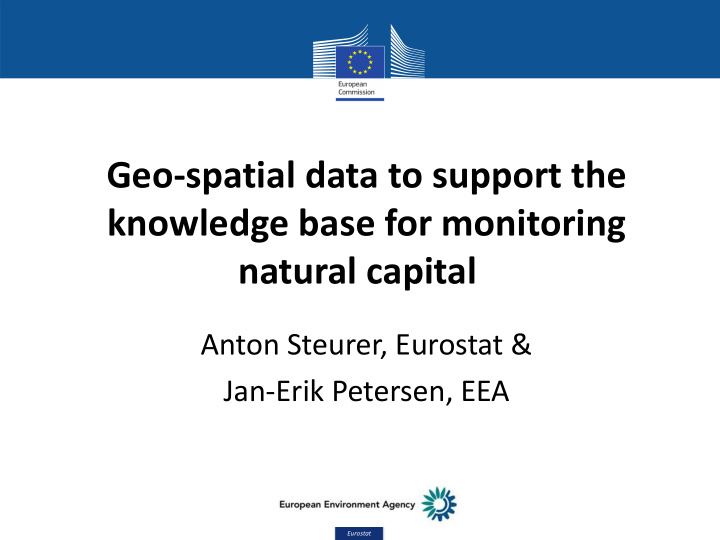



Geo-spatial data to support the knowledge base for monitoring natural capital Anton Steurer, Eurostat & Jan-Erik Petersen, EEA Eurostat
What is the policy context? • EU 7 th Environmental Action Programme – Objective 1: preserve ‘natural capital’ – Objective 5: build environmental knowledge base • EU Biodiversity Strategy to 2020: – Action 2 Mapping and Assessment of ecosystems & their services (->MAES) – Integrate natural capital into accounting and reporting systems • Environment Knowledge Community at EU level to support knowledge base for 7EAP 2
What is ‘natural capital': Focus of talk MAES working definition Ecosystem capital: Abiotic Abiotic assets: flows: Ecosystem Ecosystems as Renewable Solar service flows: asset: energy (solar, radiation • Provisioning wind, hydro..) G Extent, structure & services (food, E condition of : fibre, energy etc.) N • Regulation & E Forests, woodlands, maintenance (of R rivers, lakes, oceans, climate, river flow, A coasts, wetlands, T pollination etc.) Minerals, Phosphate grasslands, croplands, I fossil fuels, fertiliser, • Cultural services N ozone layer, radiation heathlands, urban (recreation in G gravel, protection, parks, etc. nature, spiritual etc. etc. use of nature etc.) 3
First consider: Natural and social sciences decompose objects … • … but ecosystems are more than the sum of their parts. 4
What is the challenge? I Many different & separate & expensive data gathering exercises but not really tailored towards measuring ecosystems LUCAS (ground COPERNICUS Biodiversity observation) (satellite images) monitoring Corine Forest Water FD Land Cover statistics reporting Farm Structure Survey Natura Et cetera (agricultural 2000 data census) 5
What is the challenge? II • We need biophysical accounts for direct use and as a basis for valuation studies, upscaling • We need an EU layer of accounts as a frame for countries and for EU policy -> we need the data foundation & the capacity to analyse these data • We need experiments and demonstrations with these accounts (on ecosystem capital) • We need stepwise standards & recommendations towards a common methodology => Knowledge innovation project on ‘natural capital’ 6
What is the challenge? III Tasks identified for ‘KIP’ on natural capital: 1) Identify the required information 2) Develop a shared sampling frame and an integrated system 3) Set joint minimum data standards (e.g. on geo- referencing) 4) Establish a shared data platform 5) Integrate all available data and make sure new data fit into the system 7
One of the solutions to develop: Triangulation of data sources for tracking land use & associated natural capital Satellite data (e.g. Geo-referenced Copernicus HRLs) statistical data An evolved LUCAS and/or other in-situ tools.. 8
International & EU guidance documents as framework: • United Nations, European Commission, FAO, OECD and World Bank (2014): System of Environmental- Economic Accounting 2012 - Experimental Ecosystem Accounting. http://unstats.un.org/unsd/envaccounting/seeaRev/eea_fi nal_en.pdf • European Commission (2013): Mapping and Assessment of Ecosystems and their services. http://ec.europa.eu/environment/nature/knowledge/ecos ystem_assessment/pdf/MAESWorkingPaper2013.pdf • CBD (2015): Ecosystem natural capital accounts – a quick start package. http://www.cbd.int/doc/publications/cbd-ts-77-en.pdf • And others.. 9
Next steps (the KIP) • Fully map available data sets at EU level; • Develop and implement an overall integrated information system based on a combination of various data sets, including LUCAS-type surveys and the analysis of satellite images providing layers of geo-referenced data. The system should be modular, with generic layers. • Promote further harmonisation and standardisation of data sets and environmental reporting (e.g. via INSPIRE) to make data sets developed at national and EU level more complementary; • Develop and implement a joint analytical frame (sample, data categories…) that ensures all efforts efficiently contribute to improving the data foundation.. • Establish and maintain an analytical capacity at EU level that ensures that basic accounts and analyses are available for the EU, allowing Member States and other stakeholders to develop plug-in applications. • Link and integrate this project to any forthcoming digital policy of the European Commission as well as to the European Statistical Program 2013 – 2020, with a specific 10 focus on the data revolution and big data
• Thank you ! .. 11
Recommend
More recommend